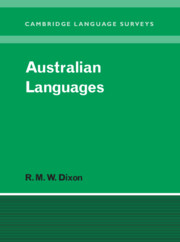Book contents
- Frontmatter
- Contents
- List of maps
- List of abbreviations and conventions
- Preface
- Acknowledgements
- Conventions followed
- List of languages and language groups
- 1 The language situation in Australia
- 2 Modelling the language situation
- 3 Overview
- 4 Vocabulary
- 5 Case and other nominal suffixes
- 6 Verbs
- 7 Pronouns
- 8 Bound pronouns
- 9 Prefixing and fusion
- 10 Generic nouns, classifiers, genders and noun classes
- 11 Ergative/accusative morphological and syntactic profiles
- 12 Phonology
- 13 Genetic subgroups and small linguistic areas
- 14 Summary and conclusion
- References
- Index of languages, dialects and language groups
- Subject index
11 - Ergative/accusative morphological and syntactic profiles
Published online by Cambridge University Press: 22 September 2009
- Frontmatter
- Contents
- List of maps
- List of abbreviations and conventions
- Preface
- Acknowledgements
- Conventions followed
- List of languages and language groups
- 1 The language situation in Australia
- 2 Modelling the language situation
- 3 Overview
- 4 Vocabulary
- 5 Case and other nominal suffixes
- 6 Verbs
- 7 Pronouns
- 8 Bound pronouns
- 9 Prefixing and fusion
- 10 Generic nouns, classifiers, genders and noun classes
- 11 Ergative/accusative morphological and syntactic profiles
- 12 Phonology
- 13 Genetic subgroups and small linguistic areas
- 14 Summary and conclusion
- References
- Index of languages, dialects and language groups
- Subject index
Summary
A pervasive theme of this book is the alternation between ergative and accusative schemes of morphological marking in Australian languages. In this chapter we extend the survey to ergative and accusative strategies for syntactic clause-linking, and investigate the types of correlation between morphological and syntactic characteristics.
It will be seen that while most languages have a mixed strategy for morphological marking, some have moved towards a fully ergative and some towards a fully accusative profile. A number of languages show ergative syntax and a fair number have accusative syntax (there being a degree of correlation between morphological and syntactic profiles) while others appear to lack any ergative or accusative orientation at the syntactic level.
§11.1 recapitulates the kinds of morphological marking systems described in chapters 7, 8 and 10 and outlines the kinds of marking shift for nouns, free pronouns and bound pronouns. §11.2 explains and describes the types of syntactic pivot encountered in Australian languages (including the phenomenon of switch-reference marking). §11.3 deals with antipassive and passive derivations; §11.3.1 discusses the suffix *-dharri, which is likely to have originally had a semantic effect but has since come to mark detransitivising derivations such as reflexive, reciprocal, passive and antipassive. §11.4 describes a number of shifts in ergative/accusative profile in individual languages. There is a short summary in §11.5.
Development of morphological marking
In chapters 7, 8 and 10 we surveyed the various types of marking, across the continent, for the syntactic functions of core arguments.
Information
- Type
- Chapter
- Information
- Australian LanguagesTheir Nature and Development, pp. 515 - 546Publisher: Cambridge University PressPrint publication year: 2002
